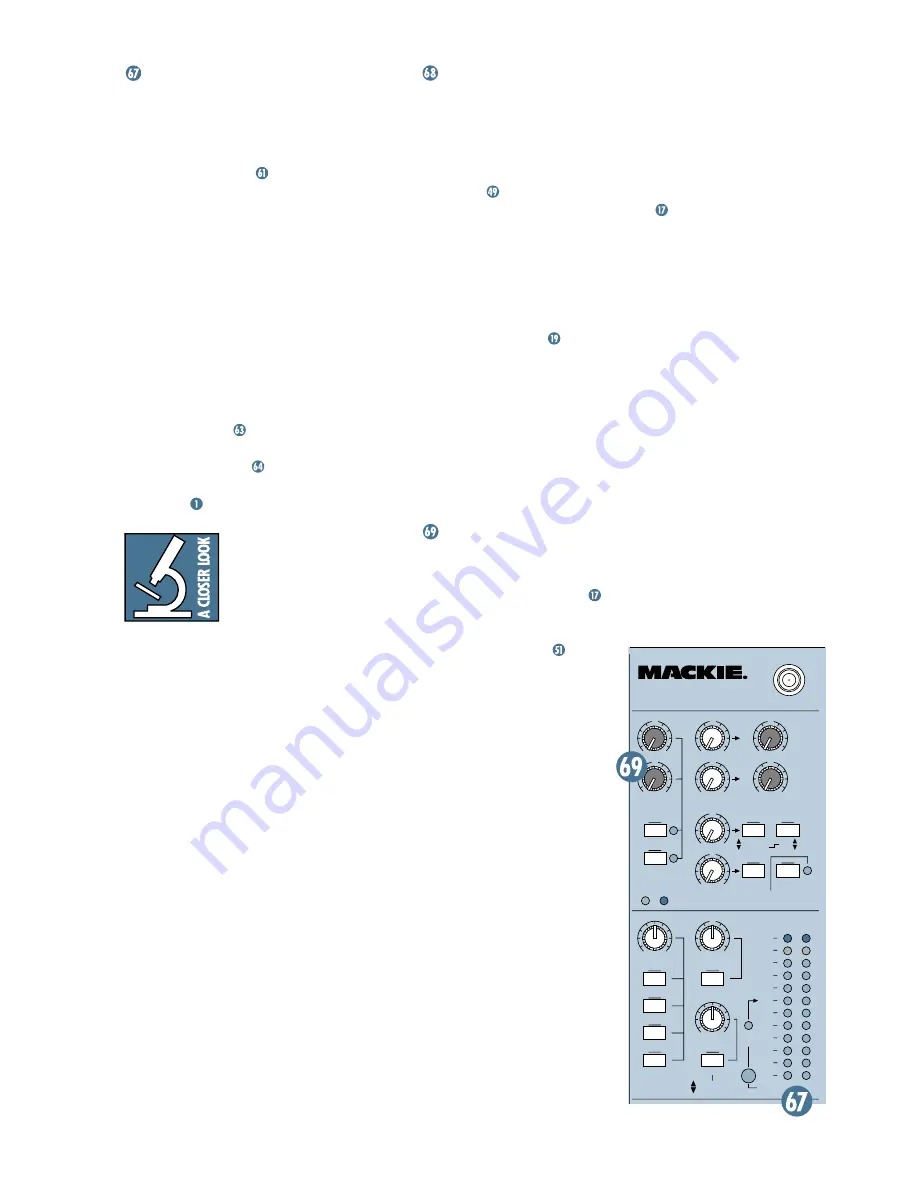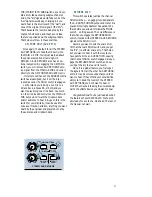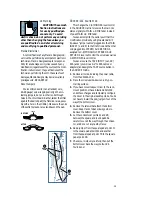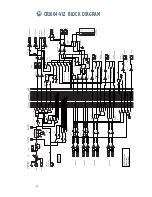
25
METERS
The CR1604-VLZ’s peak metering system is
made up of two columns of twelve LEDs. Decep-
tively simple, considering the multitude of signals
that can be monitored by it. If nothing is selected
in the
SOURCE
matrix
and no channels are in
SOLO
, the meter display will just sit there. To
put them to work, you must make a selection in
the
SOURCE
matrix (or engage a
SOLO
switch).
Why? You want the meter display to reflect
what the engineer is listening to, and as we’ve
covered, the engineer is listening either to the
C-R OUTS
or the
PHONES
output. The only
difference is that while the listening levels are
controlled by the
C-R/PHONES
knob, the
meter display reads the
SOURCE
mix before
that control, giving you the real facts at all
times, even if you’re not listening at all.
When the solo
MODE
switch is set to
LEVEL
SET (PFL)
(down)
, all soloed signals will be
sent to the left meter only. That, combined
with
LEVEL SET
LED
, are along the path of
enlightenment known as the
Level-Setting
Procedure
. During
NORMAL (AFL)
mode,
the meters will behave normally.
Meters vs. Reality
You may already be an
expert at the world of “+4”
(+4dBu=1.23V) and “–10”
(–10dBV=0.32V) operating levels. Basically,
what makes a mixer one or the other is the
relative 0dB VU (or 0VU) chosen for the meter
display. A “+4” mixer, with a +4dBu signal
pouring out the back will actually read 0VU on
its meter
display. A “–10” mixer, with a –10dBV
signal trickling out, will read, you guessed it,
0VU on its meter
display. So when is 0VU actu-
ally 0dBu? Right now!
At the risk of creating another standard,
Mackie’s compact mixers address the need of
both crowds by calling things as they are: 0dBu
(0.775V) at the output shows as 0VU on the
meter
display. What could be easier? By the
way, the most wonderful thing about standards
is that there are so many to choose from.
Thanks to the CR1604-VLZ’s wide dynamic
range, you can get a good mix with peaks flash-
ing anywhere between –20 and +10dB on the
meter
display. Most amplifiers clip at about
+10dB, and some recorders aren’t so forgiving
either. For best real-world results, try to keep
your peaks between “0” and “+7.”
Please remember: Audio meter displays are
just tools to help assure you that your levels
are “in the ballpark.” You don’t have to stare at
them (unless you want to).
AUX TALK
First of all, there is no particular alliance
between
AUX SEND 1
and
AUX RETURN 1
.
They’re just numbers. They’re like two com-
plete strangers, both named Fred.
Sends
are outputs,
returns
are inputs. The
AUX
knob
taps the signal off the channel
and sends it to the
AUX SEND
outputs
.
AUX 1
and
2
are sent to the
AUX SENDS 1
and
2
master knobs before the
AUX SEND
outputs and
AUX 3
through
6
are sent directly.
These outputs are fed to the inputs of a re-
verb or other device. From there, the outputs of
the external device are fed back to the mixer’s
AUX RETURN
inputs
. Then these signals are
sent through the
AUX RETURN
level controls,
and finally delivered to the
MAIN L-R MIX
.
So, the original “dry” signals come from the
channels to the
MAIN L-R MIX
and the af-
fected “wet” signals come from the
AUX
RETURNS
to the
MAIN L-R MIX
, and once
mixed together, the dry and wet signals com-
bine to create a glorious sound. Armed with
this knowledge, let’s visit the Auxiliary World:
AUX SENDS (MASTER)
These knobs provide overall level control of
AUX SENDS 1
and
2
, just before they’re delivered
to their
AUX SEND
outputs
. This is perfect
for controlling the level of stage monitors, since
you’ll be using
AUX 1
and
2
for this, with their
PRE
switches engaged
.
AUX
SENDS 3
through
6
have no such
control — they’ll just send their
mixes directly to their respective
AUX SEND
outputs at unity gain.
This knob goes from off
(turned fully down), to unity
gain at the center detent, with
10dB of extra gain (turned fully
up). As with some other level
controls, you may never need
the additional gain, but if you
ever do, you’ll be glad you
bought a Mackie.
This is usually the knob you
turn up when the lead singer
glares at you, points at his stage
monitor, and sticks his thumb in
the air. (It would follow suit that
if the singer stuck his thumb
down, you’d turn the knob
down, but that never happens.)
AUX
SENDS
STEREO AUX RETURNS
EFFECTS TO
MONITORS
TO AUX
SEND 2
TO AUX
SEND 1
1
2
PWR
PHAN
SOLO
SOLO
1
2
1
2
3
4
1
2
C-R / PHNS
ONLY
RETURNS
SOLO
MAIN MIX
TO SUBS
ASSIGN OPTIONS
1–2
3–4
U
O
O
+20
U
O
O
+20
U
O
O
+15
U
O
O
+15
U
O
O
+20
U
O
O
+20
U
O
O
+10
U
O
O
+10
LEFT RIGHT
LAMP
12V
0.5A
TAPE IN
SOLO
RUDE
SOLO
LIGHT
C-R / PHONES
SUBS 3–4
SUBS 1–2
MAIN MIX
SOURCE
TAPE
TAPE TO
MAIN MIX
28
CLIP
10
7
4
2
2
0
4
7
10
20
30
LEVEL
SET
TM
MODE
(AFL)
LEVEL SET
NORMAL
(PFL)
CR1604-
VLZ
16-CHANNEL MIC/LINE MIXER
U
O
O
+20
O
O
O
O
MAX
0 dB=0 dBu
MAX






























